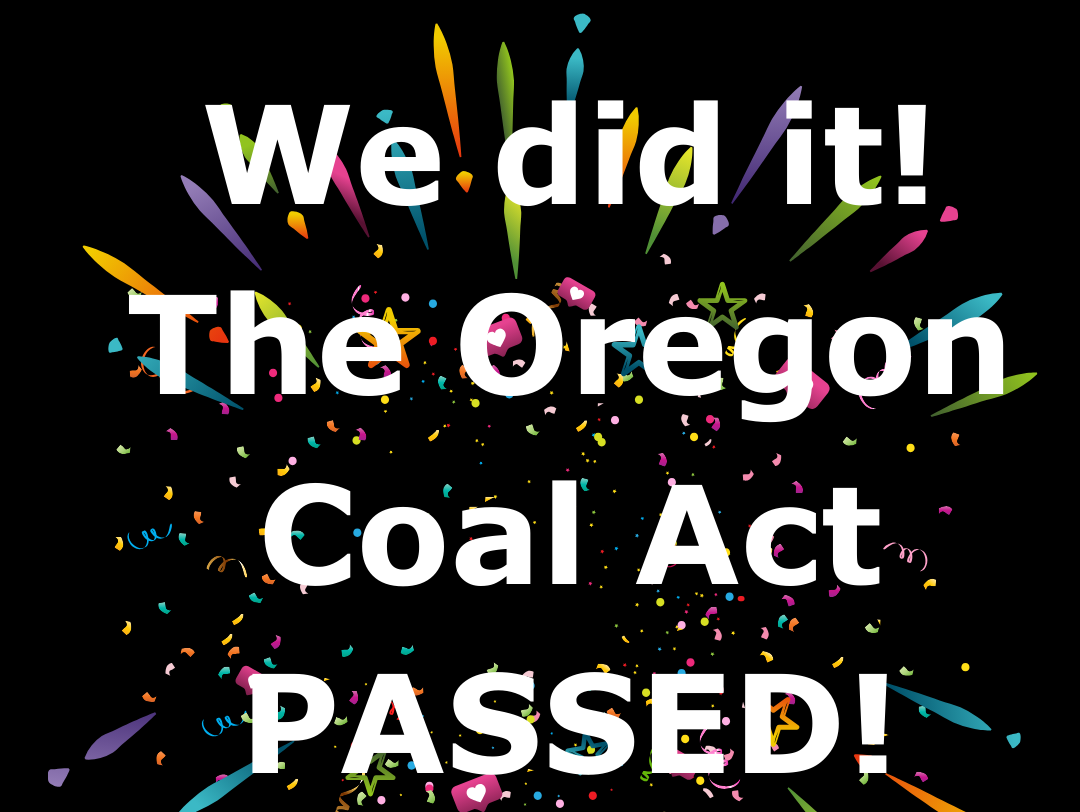Divest Oregon Responds to Treasurer Read's Net-Zero Plan
On February 6, 2024, Oregon Treasurer Read released "A Pathway To Net Zero: Positioning The Oregon Public Employees Retirement Fund For A Net Zero Carbon Future." The Divest Oregon response, provided to the Treasurer's office, is as follows:
"The Divest Oregon coalition welcomes the release of this net-zero plan. We appreciate Treasurer Tobias Read’s regular dialogue with our coalition of over 100 organizations who are dedicated to ensuring that our state pension fund invests in a sustainable future with solid returns. The Treasurer agrees with our coalition that the climate risks to PERS investments are real and require a substantial response to protect the pensions of more than 400,000 Oregonians. With the policies outlined in this plan, the Oregon State Treasury is taking an important step forward in considering these risks. But this is just the beginning: the success of this decarbonization effort requires Treasury's commitment to transparent reporting, a sense of urgency, and responsive policy-making as the effects of climate change on investment portfolios are increasingly understood. We look forward to our continued engagement with the current and incoming Treasurer, Treasury staff, and the Oregon Investment Council as they further define and implement these policies.”
What follows is the testimony presented by Divest Oregon representatives at the Oregon Investment Council meeting held on February 6:
-
Engagement & Transparency
My name is Andrew Bogrand. I am the volunteer Communications Director for Divest Oregon. I would like to start by acknowledging the Oregon Investment Council and Chair Samples for allowing many hours of public testimony by Divest Oregon over the past several years on the risks of climate change on the Oregon State Treasury’s returns. I would also like to thank Treasurer Read and his Chief of Staff, Dmitri Palmeteer, for their positive engagement with us over the past several months. Our goal has always been for Treasury to address the financial risks of climate change and we are heartened that mitigating climate risk will now be Treasury policy.
Continuing to build trust through public engagement and transparency -- now and into the future – will be critical in ensuring that this net-zero plan succeeds.
Some will worry the policies laid out in this plan will go too far in the pursuit of “decarbonization” and jeopardize returns. Others will worry that the plan will fall short of reducing fossil fuel risk.
Regardless of any one position, everyone will need to know how this plan is being implemented. In the short term, this means providing clarity on how this plan will be launched over the next year.
In my professional career, I have worked on transparency reforms at home and abroad. We know that transparency is key to building mutual trust and confidence, including when it comes to addressing climate risks and moving us closer to net-zero emissions. Transparency is not just about providing information but tracking goals, progress, and impacts. It is about building public trust and confidence.
We urge you to consider how Treasury can build and maintain public trust in its net-zero commitment. For one, the plan could use more clarity on how the OIC and the public will be kept up to date on progress and challenges. Information without engagement, or “zombie transparency,” is always a challenge. This plan must be a living document grounded in regular, positive engagement with beneficiaries, stakeholders, and groups like Divest Oregon.
In implementing this plan, Treasury should look to the UN High-Level Expert Group on Net-Zero Emissions, which has published guidelines for net-zero plans that include:
-- Establishing and publishing a timeline and deliverables for implementing the net-zero plan;
-- Describing the project team tasked with implementing the plan, including key roles and responsibilities; and,
-- Creating a comprehensive annual reporting template to credibly demonstrate progress and identify barriers on the road to net zero.
We look forward to our future engagement as an ever-broadening coalition with the Oregon Investment Council and the professional Treasury staff especially as this new net-zero plan is put in place.
-
True Net-Zero Needs to Be OIC Policy
My name is Susan Palmiter. I speak on behalf of Divest Oregon, a coalition of over 100 organizations and over 1000 individual members. We commend the Treasurer for agreeing with us that climate change 1) poses a financial risk to our State’s pension fund and 2) creates a need to mitigate the negative impact it will have on beneficiaries’ returns.
This plan represents an important and significant policy shift for OPERF.
This shift for the Oregon Treasury and OPERF, which, as proposed, will need to be sustained through the next few decades by a climate-risk aware and evolving staff, many newly elected Treasurers, and newly appointed OIC members. And through those decades, which I and many people in this room may not live to see, unpredictable impacts of the unfolding climate crisis on financial markets will occur.
As the Treasurer’s plan acknowledges, the “pathway” that will optimally protect beneficiary returns from climate risk is unknown. If anything, the climate crisis is unfolding more quickly than scientists have expected, with faster warming, more severe weather events, and more rapidly approaching tipping points - all from which there is no return. At the same time, new pathways may appear so that OPERF can hit an 80% emission reduction by 2035 and Net Zero by 2040. Other public pension funds’ are moving to do just that.
Therefore, we urge the OIC to unequivocally embrace this overall shift as OIC investment policy.
Safeguarding the fund from climate risk should not be the job of a sole treasurer or the capable Treasury staff alone; it must be OIC investment policy to be credible and long lasting. Only a policy can guide work, provide oversight, and create accountability. The OIC has statutory responsibility - as ORS 293.731 states "shall formulate policies for the investment of OPERF and the acquisition, retention, management and disposition of investments."
Given the importance of this initiative, we ask that OIC members meet quarterly with the Treasury team responsible for implementing this work - similar to the quarterly asset class team oversight you are beginning.
We also ask that you request quarterly updates from the staff at OIC meetings - outlining the progress of the net-zero plan so we are all informed of any slow-downs or stalls. The urgency is real. The time for action is now.
This Net Zero plan is inherently a policy. We urge the OIC to take an active role both in overseeing the implementation of the plan and how urgently the staff is acting to proactively protect beneficiaries. It needs to be an OIC policy.
Thank you for this opportunity to speak.
-
Financial Models Aren’t Keeping Up with Climate Change
My name is Nancy Yuill and I am speaking on behalf of Divest Oregon. I appreciate that the Oregon Treasury has developed this net zero plan. It is a foundational document that has potential to evolve into effective policy to mitigate the financial risks to OPERF from climate change.
We all see climate change accelerating across Oregon and the planet. The truth is: this Net Zero plan will only be effective if it has the ability to evolve and meet the rapidly deteriorating situation we are in and it is only as good as the financial models that are taking these changes into account.
Foremost in your mind should be an understanding that current economic models used to model financial risk from climate change are not taking into account tipping points and cascades, nor the severe price adjustments that will reflect the climate risk. Three professional articles in the past 7 months by economists and actuaries lay out the facts. I am happy to provide copies of them at your request and I cite them in my written testimony.
To summarize the findings, standard economic models fail to consider domino effects of tipping points and feedback loops, which climate science tells us are not far away-and their risks are accelerating.
To understand tipping points and feedback loops you need just imagine being on a road trip and having a hungry, tired child onboard; you know problems progress quickly and the tipping point to no return is unpredictable, and sooner than we hope. Then there is the domino effect, once one passenger in the car starts to melt down, you know more will follow in a cascading manner. That is the tipping point and feedback loop.
Current economic models are also underestimating how quickly the planet is warming, and burning through our carbon budget. And in the models, the measurement of costs from climate change damage exclude many of the risks anticipated to arise from climate change.
Ortec, who did economic modeling for Treasury in 2021 and 2022, thinks their model is underestimating financial damage because it is not accounting for tipping points or unprecedented changes in the climate system.
Economists and actuaries are shouting to us that the impacts of climate change are much worse and happening much faster than financial models are predicting.
This net zero plan must evolve to incorporate updated economic models that best reflect the rapidly changing climate and the plan needs to keep looking for where you can accelerate the move towards net zero.
The 3 referenced articles are:
-- The Emperor’s New Climate Scenario
-- Loading the DICE against pension funds - Flawed economic thinking is putting your pension at risk
-
The Plan Must Evolve Quickly
My name is Jenifer Schramm and I am representing Divest Oregon in this testimony.
Divest Oregon will follow the implementation of the Treasurer’s plan in the months ahead, and encourage improvements. As Andrew discussed, we assume that the Treasury will create public trust in the plan by making plan progress accessible to all interested parties.
An example of a necessary improvement to the plan is incorporation of all emissions data. Currently, the plan does not require reporting on greenhouse gas pollution resulting from the use of OPERF’s fossil fuel investments – scope 3 emissions. Instead, the baseline measures only emissions from the production of those fuels – scope 1 and scope 2 emissions. This unmeasured and unreported scope 3 pollution has a huge impact on the climate and a huge impact on the risk to OPERF investments. Again, this plan currently only measures pollution from the production of fossil fuels, not the actual and intended use of the fuels.
This is like measuring cancer risk from cigarettes by measuring cancer risk from growing tobacco and operating cigarette factories, while totally ignoring the cancer risk caused by actually smoking the cigarettes produced by those investments. Treasurer Read’s plan on page 40 notes that “As the standards and reporting improve around Scope 3, Treasury will look to incorporate that data into our decision making.” Some corporate reporting of Scope 3 emissions, including reporting for Big Oil, is available now. Why not use it?
This is just one example of the need for ongoing updates of the plan. You can be sure that as the Treasury and the Oregon Investment Council inform the public how the plan and the implementing policy evolve on key issues, the Divest Oregon coalition will keep an open door and continue to look for updates and improvements.
-
Climate Urgency
My name is Gary Wallmark. My wife Linda and I are retired PERS members from Eugene. I’m a volunteer for Divest Oregon concerned about the stability of our retirement system as the climate continues to change.
I thank the Treasurer for presenting his Net-Zero investment plan and the Oregon Investment Council for considering how Oregon can best transition toward greener, safer investments. I’m glad this proposal is being made now rather than after the next Treasurer comes into office. It’s a blueprint we can start building upon now.
Some might think, “We’ve got this covered—nothing more to do.” That would be a mistake.
My wife and I spent the last 50 years hiking throughout the west. We heard a little about the prospect of climate change years ago but it seemed VERY distant — it “wouldn’t be a problem for generations”. Then we started seeing things change — sometimes slowly, sometimes fast.
We planned a trip to Mt Rainier in the 80s to hike in the glacial ice cave, but the week before we left the cave was closed — car size ice chunks were falling from the ceiling. SURPRISE. As we returned to the park over the years, we saw that the huge Nisqually glacier kept receding up the mountain. It became difficult to see glaciers in Glacier National Park. SURPRISE.
River levels were dropping. Rafting on the Colorado, we encountered a rapid that shocked our experienced guide — it hadn’t been there in more than a generation and wasn’t there just days before. SURPRISE.
And large expanses of forest, in Oregon and throughout the west, were sick and dying. More wildfires, more smoke, more closed roads, more charred land, more burned communities. SURPRISE, SHOCK, LOSS, and GRIEF.
The predictions were wrong - the earth is heating faster than expected. We feel and see it. Things that were supposed to happen “IN THE FUTURE” are happening NOW. Change is non-linear — chaotic with sudden, unanticipated consequences. SURPRISE. This is no longer a problem only for remote future generations. It is OUR problem and will become an even bigger problem for our children and grandchildren. No wonder the state has adopted policies to reduce greenhouse gas emissions.
These accelerating disruptions are sapping our state retirement savings. The S&P 500 fossil fuel energy sector is worth barely more today than it was 10 years ago. Investments that once seemed sound may become costly stranded assets. SURPRISE—and OUCH. We don’t want our portfolio to be filled with “buggy whip” investments.
We would like the Treasury to divest NOW from fossil fuels, as the New York pension fund has done. But we are glad Treasurer Read has taken this first step. We, and other PERS members and retirees, will watch how quickly Treasury implements the plan, and watch how the next Treasurer builds on it to protect our PERS investments.
Far-sighted leadership will be required to avoid more SURPRISING OUCHES.











